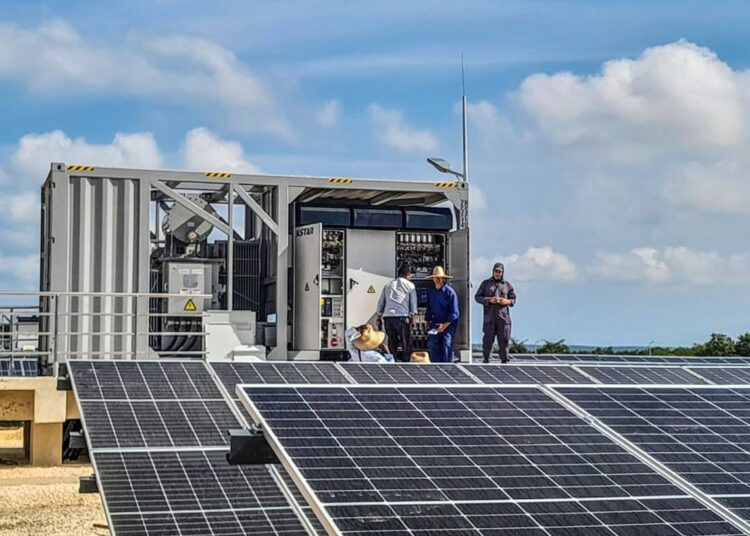The fourth month of 2025 has reached its midpoint, and Cuba’s electricity situation, even with the new solar parks installed, still shows no plausible signs of improvement.
Although generation has increased slightly compared to the most acute peaks of the crisis, and for a few hours in the early morning, the deficit has been overcome, demand has also been increasing, and blackouts continue to last for hours across the island.
Furthermore, several thermal power plants remain offline every day due to breakdowns or maintenance, while the fuel shortage — although its impact fluctuates in official reports, is a sword of Damocles for the fragile National Electric Power System (SEN). Not to mention that 94 distributed generation plants were shut down this Tuesday for this reason.
In this context of deficit, the new solar parks — the government’s flagship project to alleviate the country’s energy crisis in the short term — have been able to do little so far and are paying the price in the public eye. At the end of March, eight new parks with a capacity of 21.8 MW were operating, and two weeks later, that figure remains the same.
Authorities have promised to install five more parks in April and exceed 50 by the end of the year, bringing the combined capacity to exceed 1,000 MW. The installed capacity so far only reaches 174.4 MW, which means that this is the maximum possible generation of the eight currently operating.
This capacity, although greater than that of several thermal units on the island, is less than that of the most powerful blocks, such as Guiteras or Felton 1; and also — by no small amount — than the MW that are no longer generated each day by units outside the SEN, plants shut down due to lack of fuel, and even the thermal limitations of synchronized plants.
Therefore, it is not difficult to understand why, until now, although the electricity generated by these parks has contributed to reducing the impact, its effect has not yet been felt, “drowned out” by the high deficit that prevails day after day.
Thus, the blackouts continue unabated, and the improvement promised by the authorities “is not immediately visible,” Lázaro Guerra, director general of electricity at the Ministry of Energy and Mines (MINEM), admitted a few days ago. “But as we continue to install more parks, the improvement should be seen,” he added.
Solar parks vs. blackouts: between illusions and reality (I)
Behind the math
The new solar parks are not like thermal units and distributed generation engines. They don’t need oil to produce electricity, but since their energy source is the sun, they don’t generate electricity constantly.
First solar park connected in project to curb energy crisis in Cuba
Their electricity production, as Guerra explained, “is not so linear, because its greatest impact is during the day, around noon.” According to the executive, it is “from 11:00 a.m. to around 3:00 p.m.” that these parks “are delivering practically all their power,” which, he asserted, “goes directly to reducing the impact on the service.”
“If these parks weren’t operating, the impact during those hours would be even higher than it is now,” he noted. The deficit estimated by UNE at noon has been around 700 MW in recent days, but in recent weeks it has exceeded 1,000 MW, even with the solar parks producing at a good pace.
For new installations to effectively contribute to eliminating blackouts at that time, they would have to contribute significantly more. That is, they would have to increase their number significantly, reaching a combined total of MW presumably greater than the current midday deficit.
A substantial increase in the number of solar parks to 21.8 MW — a program that includes the installation of 92 over several years, with at least 50 of them by 2025 — is a sine qua non for the long-awaited end of blackouts. But other conditions must also be met.
To begin with, the solar parks must not only be installed, but they must also generate the best possible output. In a country with such radiant sunshine as Cuba’s, this seems guaranteed, but even so, generation can vary due to external and weather factors and could be affected by technical issues arising from the installations, their management, upkeep, and maintenance.
The fact that, even with only eight installed, the parks’ production is not constant is shown by the UNE’s own reports. In these, although the total generation figures are often similar, they have generally fluctuated between more than 1,000 and less than 800 MWh, which is the amount of electricity generated throughout the day and should not be confused with power, which is the maximum instantaneous energy that can be delivered to the SEN.
The other fundamental element is that, as we mentioned, to eliminate or reduce blackouts — at least daytime ones — generation from other sources, such as thermal and distributed energy, must grow alongside solar parks. And to achieve this, it is necessary to increase capacity by incorporating units outside the system and minimizing impacts due to fuel shortages.
The authorities have pointed precisely to this in their most recent public statements, in which they have referred to a strategy to progressively recover thermal units and generators. They have reiterated, to lessen public expectations about the new parks, that “solar photovoltaic energy alone is not the solution to the electricity situation.”
Nights, plans, and the final word
While the existing solar parks can do little for the time being to address the daytime deficit, their contribution at night is still nil. The reason is not only that there is no sun during those hours, but also that the new installations lack the capacity to store energy. At least not all of the ones being built.
“These parks do not have battery storage systems; this means their energy is injected directly into the SEN during the day,” Geider Mompié, director of the Granma province Electricity Enterprise, recently confirmed.
For his part, Minister of Energy and Mines Vicente de la O Levy explained in an interview a few days ago that as part of this project, “we plan to incorporate batteries to deliver energy for four and five hours,” but this will be a “second step,” “when the investment process for solar photovoltaic energy is well advanced.”
He also explained that storage systems would be installed to “stabilize the system,” distributed across four 50 MW parks. Asked directly about plans for 2025, De la O explained that “100 MW of these stabilization batteries and 150 MW of energy delivered to the system” were to be installed this year, although he did not elaborate on the work of these batteries or how they would contribute to the SEN.
The provincial director of Granma was a little more precise, stating that as part of the program, “10% of the storage systems were also acquired to be integrated into transmission substations, such as the one located in Trinidad, which supplies power to the province and where 50 MW of photovoltaic energy will be installed.”
“The battery banks are not designed to provide power for long periods, but rather to regulate the system’s frequency. When a park’s production is interrupted, for example, due to cloud cover, these battery banks would supply the necessary charge for a maximum of three hours,” he explained.
Seen this way, even if the new solar parks continue to grow to the projected figures and manage to accumulate some energy, it doesn’t appear that their contribution will be significant outside of their peak operating hours. Therefore, authorities have insisted that their fundamental value, in addition to producing during the day, is the saving of fuel that could then be used to generate at night.
In general, as part of the ongoing government plan — in which the new solar parks are a key element — the Ministry of Energy and Mines (MINEM) plans to incorporate 2,000 MW into national generation based on all sources between 2025 and 2026 and cover all daytime impacts starting midway through this year, as estimated by the minister last December.
“This doesn’t mean that blackouts will be completely eliminated. It’s a gradual, costly process, an investment process for which the light is seen at the end of the tunnel,” De la O stated in his recent interview, specifically regarding plans to expand photovoltaic energy by approximately 1,000 MW this year.
Meanwhile, President Díaz-Canel assured Spanish journalists a few days ago that with the investments being implemented, “in a few months, during daylight hours, we shouldn’t have blackouts,” and that with the continuation of these plans next year, the SEN “will be in a better position.”
“With photovoltaic energy, we’ll be able to withstand the day,” he said. “And, therefore, we’ll have more distributed generation blocks to support the nighttime. But, in addition, we’ll also have more capacity available at night in thermoelectric plants,” he promised.
However, beyond the government’s plans and strategies amid the prolonged energy crisis, time will once again have the final say.
________________________________________
Solar parks vs. blackouts: between illusions and reality (I)











Get help from China. They have the best solar technology in the world.